In Europe, there are over 300 churches dedicated to the Black Virgin/ Madonna, with over 140 of these Black Virgin sites being in Southern France.
It is estimated that over 500 Black Virgins reside in France with only some being documented and not all have been found.
In the Middle Ages, Black Virgin/Madonna iconography surfaced in rural areas where strong pre-Christian and Celtic traditions existed and included the worshipping of powerful female deities.
Even earlier than the 10th century CE, large numbers of Black Virgin statues existed along the pilgrimage routes to the Holy Land. These sites are said to rival the sacred religious sites of Rome and Jerusalem in popularity.
But unlike her contemporary older deities, for example, Isis and Ishtar, the Black Virgin Art did not disappear into insignificance as the others have.
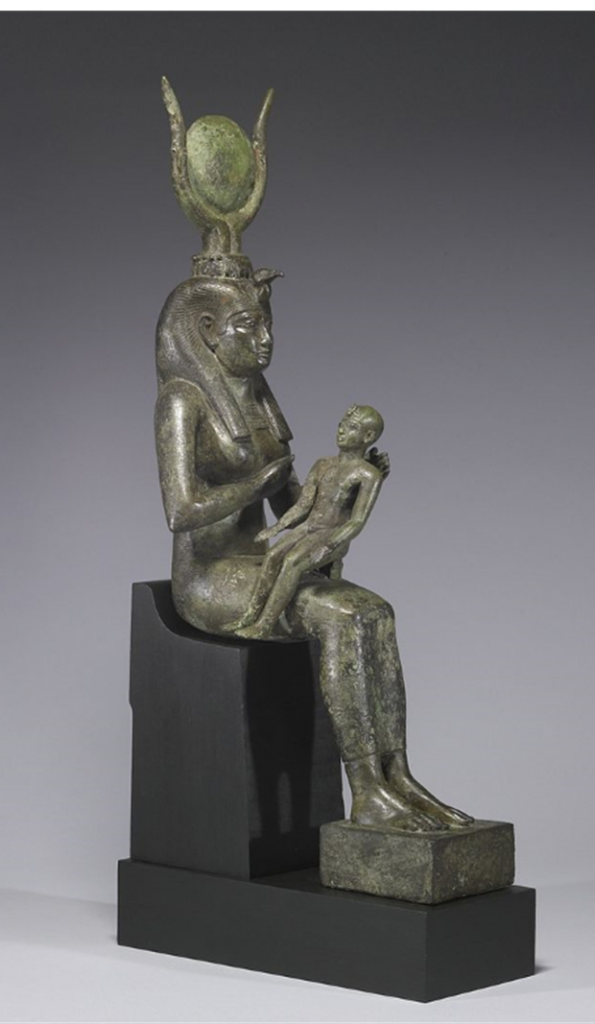
It is interesting to note that, Christianity saw the Black Virgin or Madonna as an obedient gentle woman, a good example of what a woman should be, but the ancient goddess Isis with her child Horus is something else. She is mysticism. When Isis worship stopped, the Black Virgin adoration started and, it is also interesting to note that after 15 century CE the breast-feeding virgin was forbidden officially by the church, one of the first banned traditions.
Isis breastfeeding Horus
Source: Wikipedia
The Black Virgin offers insights, healing, miracles and the restoration from their troubles, expanded her pilgrimage.
Ancient writers say her devotion multiplied every year, something that is still growing even today.
The feminine goddess worship from the past is now given the label of legends, perhaps even folklore, yet we find that our Black Virgins/ Madonnas are really an ever-present source of spirit.
Iconography
The Black Virgins have particular traits which consistently present a pattern.
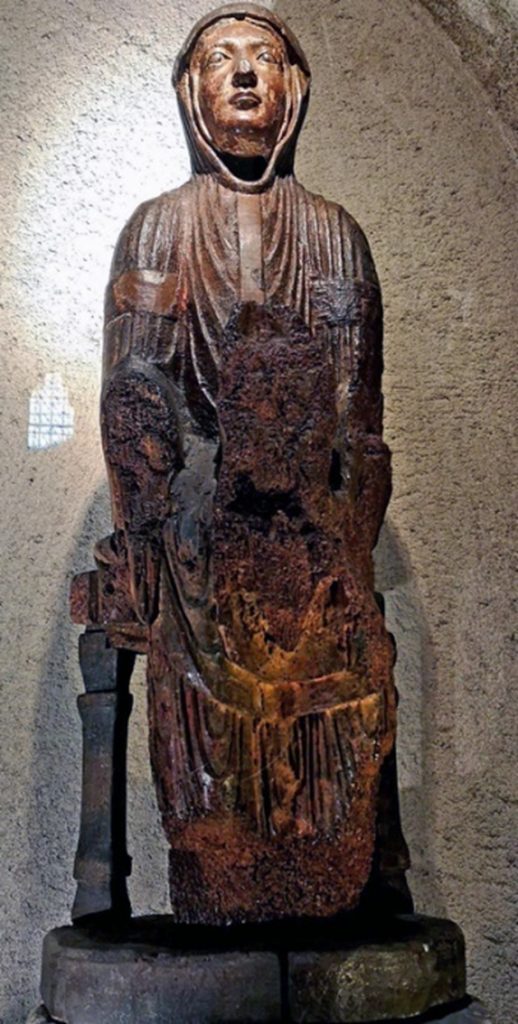
Firstly, when looking for the traits of the Black Virgins, one important and distinguishing factor is that she sits in ‘majesty’. The Virgin sits in a dignified pose with a straight back posture and, in most representations, her back does not touch the backrest. This is the same seating as the representations of Isis.
Usually, her eyes look as if to stare in a dream-like manner, conveying her emotion. In some, she conveys sadness, in others worry, hope, understanding or even a deep knowing. Other Virgins have been described as having eyes that are empty, maybe as an open invitation to non-judgment.
Notre-Dame de la Rivière in the former abbey church of Saint-Pierre. Beaumont, France
Source: Lieux Sacres
Other Symbolism
Below are examples of common symbolism and their meanings when used in the representation of our Black Virgins.
The symbols had a lot of meaning and made sense to the people as most were illiterate over the period when the Black Virgins emerged.
Her colours are chosen for their symbolic meaning and are often linked to the ancient alchemists.
Looking at the archaeology of the ancient Goddess culture, some of the symbols used were concentric circles, spirals, serpents, flowers, moon, nakedness, large buttocks, and breasts, and their faces were mostly devoid of expression.
What is interesting is that at these archaeological dig sites, we find no male representations in sculpture.
Our Black Virgin representations use symbols that are sometimes easy to spot, and others are hidden away but once you practice your gaze on her you will see.
Some of these symbols are as follows:
Apple: A symbol of Adam and Eve and the forbidden fruit, therefore you will see an apple placed in the hands of Mary, maybe a reminder to not succumb to worldly temptations.
Birds: Doves symbolize purity, peace, and the Holy Ghost. An eagle represents new life and is used to symbolize the resurrection.
Colour: Dark skin or veiled is deemed to represent the night and/or darkness. Red reflects the earth and the female cycle. Blue symbolizes ancient waters or the sea, an example being Black Madonnas arriving by boat.
Crowns: Reflects her “queenly” and regal status, also a goddess who is not married or is a virgin.
Dark Skin: Reflects the source of us all. The links to the first mother of Africa. It also represents night and darkness.
Dragon and/or Serpent: Symbolizes the devil, the enemy of God over which she has the capacity to conquer.
Ears: Open to hearing prayers. Also means a symbol of betrayal to the passion of Christ’s story.
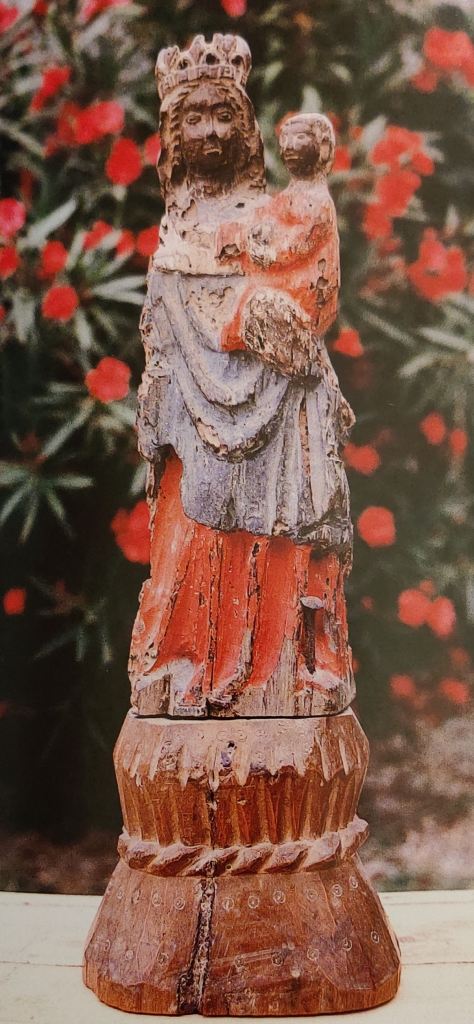
Egg: When eggs are depicted near or being held by the Virgin this reflects an incredibly old image of resurrection.
The emerging chick breaking from the egg at its birth represents resurrection and life.
To our left is the Black Virgin who is African in iconography – Notre Dame of Eggs. It is not uncommon to find eggs all over the community church. This 10metre x 5metre building is in the care of “Friends of Greoux”.
Notre Dame of Eggs/ Notre Dame des Oeufs , Bouches-du-Rhone, France
Source: Vierges Noires Page 143
Eyes: Represent all-knowing ever-present God, the eye of God, the eyes of the Lord in a triangle represent the Holy Trinity.
Fleur-de-lis: The emblem of the royal bloodline, including the Kings of France.
Gold: Projects her shining Light in the world.
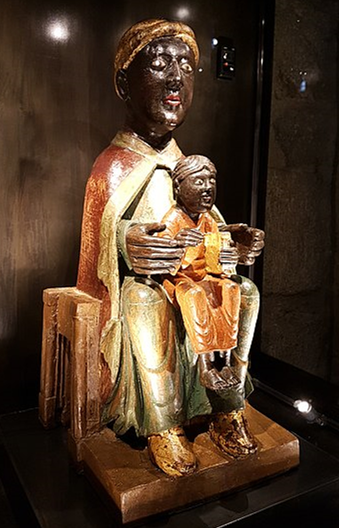
Large hands: A great many representations of the Virgin have her with hands larger than life size. They can be quite unbalanced to her body, leaving her slightly distorted. Some say her hands are big to demonstrate her ability to heal with them.
Our Lady of Meymac, France – 12th Century
Source:Wikipedia
Hair: Loose flowing hair shows penitence. Mary Magdelene washed the feet of Jesus with her tears and dried them with her hair. Hermits grew their hair long. Unmarried women in ancient times wore their hair loose and exceptionally long. A lot of Mary Magdelen statues show her with long flowing hair.
Heart: Source of understanding, courage, sorrow, joy and love. A heart carried by a saint or virgin is symbolic of love and devotion. A flaming heart means religious passion. The heart pierced by an arrow signifies profound repentance under conditions of extreme trials.
Lilies: It also is a symbol of purity: the flower of the virgin. The lily symbol reflects purity, the flower of the Virgin. It also almost always is referring to the Black Virgin by way of Isis, Hera, and/or Aphrodite. The lily shape resembles a women’s vulva – the doorway to pleasure and life giving.
Moon:
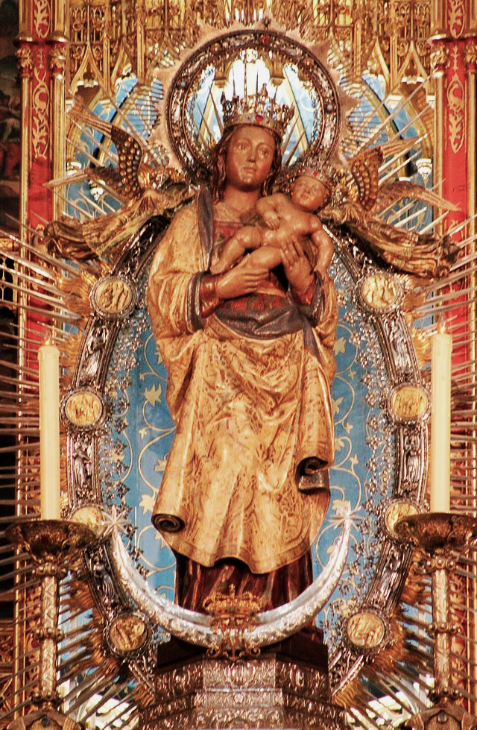
When Black Virgins incorporate the moon motif, it is usually either on or around her head, displayed behind a standing Virgin or near her feet like the pictures seen here. She is of course the moon goddess Juno. Juno in ancient Roman times was “Queen of Heaven” the bringer of Light.
Here the half-moon symbol is in mid waxing or waning phrase, either convex (exterior) or concave (inward) thus, it has not quite completed the cycle of life/ death, fertility, pointing to a change in seasons, the tides of rivers and the sea, menstrual cycle.
Moon Goddess Juno
The Virgin of Almudena (Virgen de la Almudena) Madrid, Spain.
Source: Wikipedia
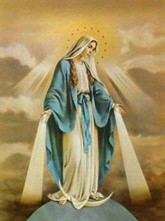
In this representation Mother Mary stands on a crescent moon.
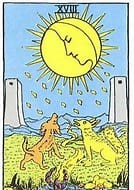
In the Tarot pack ,the moon card interestingly has a full moon with a crescent moon inside it, all encased in a sun. The face looks down into the water creating a reflection. This invites a time to meditate on your spiritual journey and tune into the emotions that the moon represents.
Nudity: There are different types of nudity. 1. The natural state of man/woman as they are born into the world. 2. Where he or she is shown with a lack of worldly goods and possessions equalling to poverty. 3. the use of nudity as a symbol of purity and innocence, and the need to overcome evil and temptation. 4. A symbol of lust and a lack of good qualities.
Owl: In ancient times, the owl symbolized Satan, reflecting its love of the darkness and fear of the daylight. The symbol of the owl is often seen around hermit monks yet today it is more commonly looked at as a symbol of solitude.
Red Rose or Petals: Menstrual Blood and the vulva.
River: The ancients believed that there were four main sacred rivers that flowed to paradise.
Silver: Reflects her wisdom, and also her Light.
Stars/Crown:
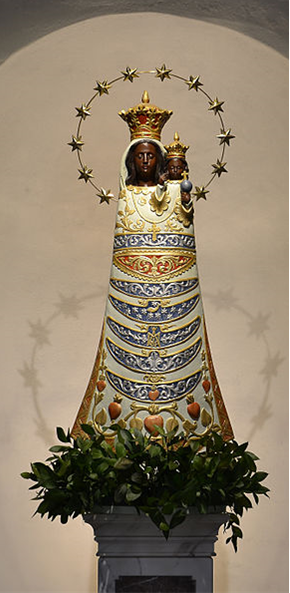
Here in this picture, we see stars around her head representing the 12 astrological stars.
‘A great sign appeared in the sky, a woman clothed with the sun, with the moon under her feet, and on her head a crown of twelve stars.’ – Revelation 12:1
When we look at our study of Black Virgins, we note that the church has decked her out with a ‘halo’ of sorts which is meant to mean or to be golden in the circle of perfection.
The symbols of stars or crowns are also used to reflect a sacred figure. Sometimes the Black Virgin has sunbursts coming out of her head, golden roses mixed with stars.
Modern touches include having rhinestones and crystals and even light bulbs attached, to remind us that she is creating an illuminating effect. As if we don’t know that…
Our Lady of Loreto type Black Madonna from Wrocław (Breslau), Silesia (Poland; Czech Republic; Germany) • Source: Wikimedia Commons
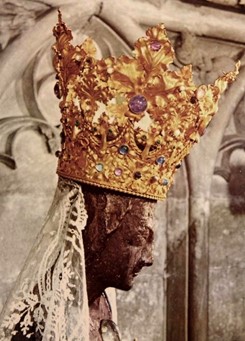
It looks like the humble stars showing the esoteric spirit and nature of our Black Virgin has manifested into the crown. As we can see in the picture, the crown was created bigger than her head reflecting the magnificence of her essence over ego.
However, something else to consider is that the church also has a bigger, the better or the richer, more costly the crown, the greater the following and patron in the church.
Source: Pinterest
Trees: Represent the body of the goddess, also the ancient tree of life, particularly in wooden statues. It is also an ancient symbol of the Virgin reflecting her strength, faith, and virtue. The symbolism of trees extends to the type of tree used to carve a Virgin. For example, oak trees are an ancient symbol of the Virgin Mary. Olive trees, especially the branch, are a symbol of peace. The pear trees were used alot to carve Black Madonnas. The pomegranate tree is an early Christian symbol of unity, and throughout all churches the Tree of Jesse is symbolic only and is the representation of the genealogy of Christ to an ancient forefather Jesse.
Stars: Symbolizes Divinity, the morning star and the evening star which lights up the heavens at night. Perpetually a symbol of divine guidance, for example, the star of the Magi, the twelve stars, and, of course, Mary was the Star of the Sea.
Scallop Shell – Pecten Maximus: This is the common seawater bivalve mollusc commonly used to mean pilgrimage. It is the emblem of St James used to reflect his resurrection from the sea where he emerged covered in scallops. The scallop shell was also commonly used for receiving offerings of food and water during a pilgrimage. This fast became the symbol for the Black Virgins. Follow the scallop shell and you will find her.
Skeleton: If human it is a symbol of death. Often, in the one hand, it carries a scythe meaning the cutting short a life, and in the other hand an hourglass, meaning a swift passage.
Water: Used for cleaning and purifying and washing away our ‘sins’. Also used for baptism, the gospels mention floods – “I’m in deep water”, and when the Virgin holds the chalice it may reflect the eucharist using a mixture of wine and water to represent the shedding of blood.
Well: Represent the foundations of life and rebirth that equals baptism, as does the fountain of the Virgin which is called “the fountain of the living waters”.
Wings: Symbolises the divine mission in life. For example, the four evangelists Mark the lion, Luke the ox, Matthew the man, and the eagle of John are depicted as winged creatures.